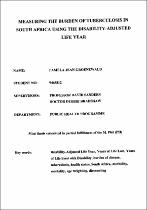| dc.contributor.advisor | Sanders, David | |
| dc.contributor.author | Groenewald, Pamela Jean | |
| dc.date.accessioned | 2022-12-06T11:27:21Z | |
| dc.date.available | 2022-12-06T11:27:21Z | |
| dc.date.issued | 1999 | |
| dc.identifier.uri | http://hdl.handle.net/11394/9478 | |
| dc.description | Magister Philosophiae - MPhil | en_US |
| dc.description.abstract | The formulation of priorities for the allocation of health resources is becoming increasingly important for health policy makers (Janovsky 1996). The gap between the resources allocated for health care and the demand is growing. This has been exacerbated by increases in life expectancy, advances in technology and stagnation in public spending (Harn 1996). Objective, comparable and reliable affirmation on health status is essential for setting health priorities (Murray 1996). In order to allocate public health resources appropriately, information on the interventions available to address priority health problems, their costs and their effectiveness, is also required (Murray 1996; Bobadilla
1996). Health status has traditionally been assessed in terms of mortality. However, with increasing life expectancies it has become more important to include assessments of morbidity. During the past few decades, extensive work has been done on the measurement of non-fatal health outcomes. Some of this work has attempted to develop time-based measures of health status that combine information
on mortality and morbidity. The development of the disability-adjusted life year @ALY) is the latest step in this process (Murray 1994;Murray 1996). The DALY is a measure of the time lost due to both premature death and disability, adjusted by a discounting and an age-weighting fiction It was developed as the measure of health status for the Global Burden of Disease study (GBD) which was commissioned by the world Bank and world Health organizationnlgg2 (world Bank 1993). Despite the fact that much of the data required for calculating the DALY were not available and estimates had to be used, the findings of this study have provided the first comprehensive picture of current health needs in the world. This has contributed much to the current debate on setting global health priorities within the health sector. One of the consequences of this study has been the promotion of national burden of disease studies, in order to improve the quality of data on health
status. This win enable the accuracy of future global burden of disease estimates to be improved. | en_US |
| dc.language.iso | en | en_US |
| dc.publisher | University of the Western Cape | en_US |
| dc.subject | Disability-Adjusted Life Year | en_US |
| dc.subject | Years of Life Lost | en_US |
| dc.subject | Years of Life lived with Disability | en_US |
| dc.subject | Burden of disease | en_US |
| dc.subject | Tuberculosis | en_US |
| dc.subject | Health status | en_US |
| dc.subject | South Africa | en_US |
| dc.subject | Morbidity | en_US |
| dc.subject | Mortality | en_US |
| dc.subject | Age weighting | en_US |
| dc.subject | Discounting | en_US |
| dc.title | Measuring the burden of tuberculosis in South Africa using the disability-adjusted life year | en_US |
| dc.rights.holder | University of the Western Cape | en_US |

